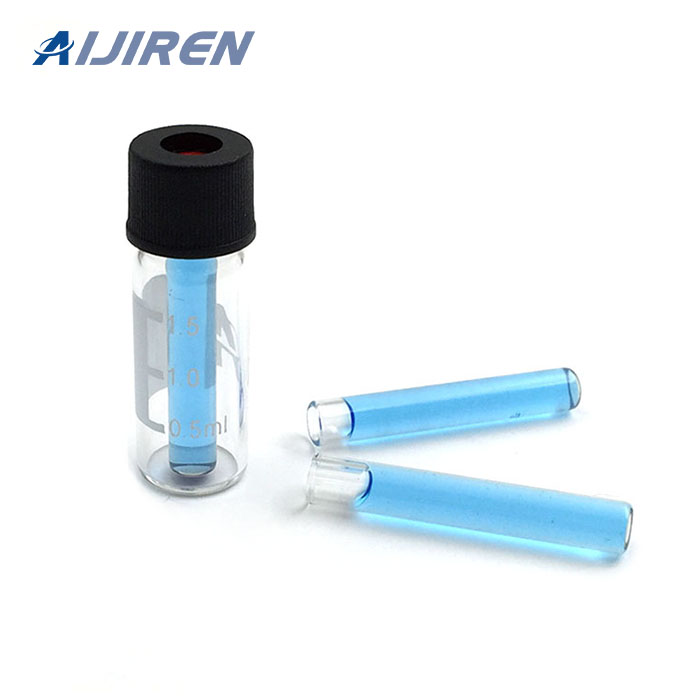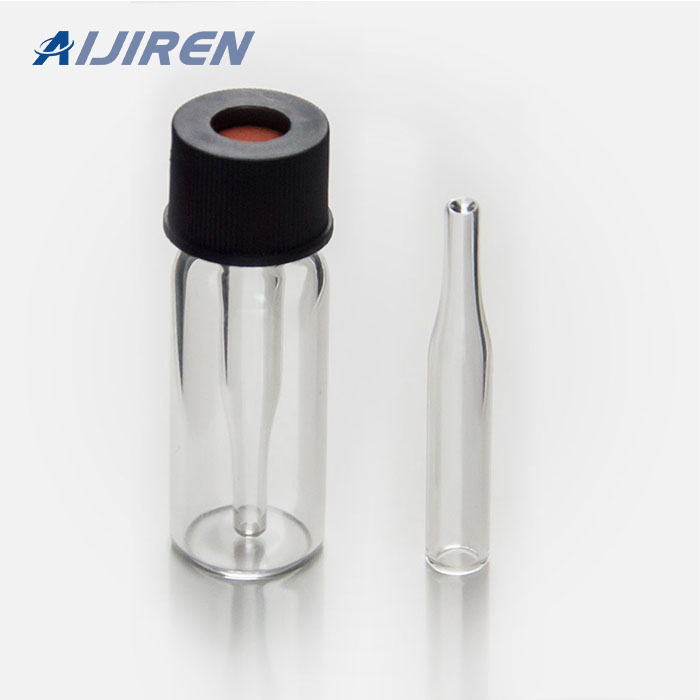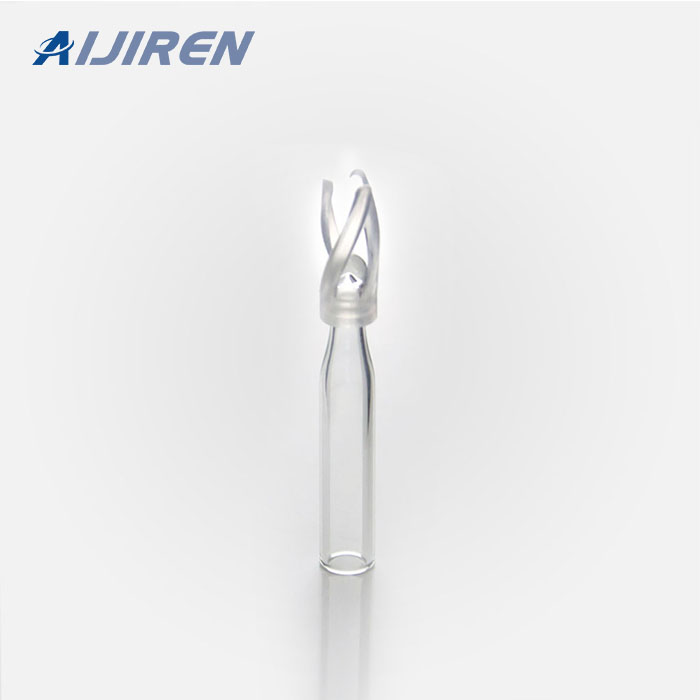





Inserts for HPLC vials (100-ml deactivated glass inserts with polymer feet EQUIPMENT and mandrel interior; Aijiren, cat. no. ) . HPLC system with electrochemical detection system (optional, see Step 53, .
Chromatography Vials, PTFE/Silicone Septa, HPLC Vials manufacturer / supplier in China, offering Gc Plug for Shimadzu Gcs Thermolite Color Vial Tubular Bottle, 11mm Crimper for 11mm Crimp Caps Seals Ajrc11-II, 11mm Crimper for 11mm Crimp Caps Seals Ajrd11-W (Economy TYPE) and so on.
Hot Selling 2ml HPLC Vial Insert for Sale-Aijiren Hplc Vials . Free sample hplc insert conical for lab use Aijiren 2020-09-21 China Laboratory Vial Manufacturers,Suppliers,buy conical micro insert for wholesales 1. 1.5ml/2ml Short screw Thread ND9,wide opening
250uL Micro-Insert with Mandrel Interior and Polymer Feet, 29x5.7mm for 9mm vials 250uL Micro-Insert, conical bottom, 31x6mm for 9mm vials, 300/pk TSH-CV2046 $47.99
Max Recommended Aijiren CrossLab Description Fill Volume Fill Volume Unit Part No. Conical insert with polymer feet 350 µL 250 µL 100/pk 8010-0131 Pulled-point insert 350 µL 250 µL 100/pk 8010-0132 Flat bottom insert 440 µL 400 µL 500/pk 8010-0136 250 µL conical insert with polymer feet, 8010-0131
50 µL Glass Big Mouth Conical Limited Volume Insert, Precision-Formed Mandrel Interior, w/Bottom Spring 250 µL Glass Big Mouth Conical Limited Volume Insert, Precision-Formed Mandrel Interior, w
PRODUCT LIST OF AIJIREN - Hplc vials. 150uL Micro-Insert with Mandrel Interior & Polymer Feet, 29*5mm, Suits for 8-425 Vials 100 IP150-I 150uL Micro-Insert with Mandrel Interior & Polymer Feet, 29*5mm, Suits for 8-425 Vials, EconomyPackage 100 IV150 150ul Insert , Conical Bottom, 31*5mm, 100. Quote Now.
Types Of Inserts: Description: Max. Fill Volume: Recommended Fill Volume "All New" Residual Volume: Unit/pk: Part No. For Wide Opening Vials (Aijiren Autosamplers) Conical: Conical glass insert with polymer feet and mandrel interior: 350 µL: 250 µL <3 µL: 100: : Conical: Deactivated conical glass insert with polymer feet and mandrel
Micro-Inserts & Shell Vials & Racks &Crimper 100pcs/pack. 150ul Insert with mandrel interior and polymer feet, 29*5mm; suits for ND8 Vials. 250ul Insert with mandrel interior and polymer feet, 29*5.7mm; suits for ND9 Vials. 200ul Micro-Insert,31*5mm,clear glass,flat bottom; suits for ND8 Vials
250uL Conical Micro-Insert, 31*5.7mm, Suits for 11mm Crimp-Top Vials 250uL Micro-Insert with Mandrel Interior, & Polymer Feet, 29*5.7mm, Suits for 11mm Crimp-Top Vials 0.3mL Clear PP Crimp-Top Micro-Vial, 11.6*32mm
HPLC Method Development Systematic Approach vs Random Walk Improving the Efficiency of Method Development and Optimization William Champion Aijiren Technologies, Inc. 1-800-227-9770, opt 3, opt 3, opt 2 lc-column-support@Aijiren.com Oct 3, 2012 Improving HPLC Separations Aijiren Restricted
Deactivated glass inserts with polymer feet. Conical with precision-formed mandrel interior and attached feet. Silanized to close off all active sites, 100 µl 5182-0649 Polypropylene inserts with polymer feet. Conical with precision-formed interior and attached feet, 100 µl Part No. Description (100/Pack) Pulled-point
These inserts are the best choice when using low volumes of biological or basic compounds that might interact or adsorb to borosilicate glass Specifications Part No Size Packaging Description IPA150 29*5mm 100PCS/PK 150ul Insert with mandrel interior and polymer feet, 29*5mm; suits for ND8 Vials IPB250 29*5.7mm 100PCS/PK 250ul Insert with
HPLC Micro-Inserts for 10-425 HPLC Vials There have five types of HPLC Micro Insert suitable for 10-425 hplc vials, I300 300uL with Flat Bottom, IV250 250uL Conical Micro-Insert, IP250 250uL Micro insert with Mandrel Interior & Polymer Feet, IV250-I(Economy), and IP250-I(Economy).
250ul Insert with mandrel interior and polymer feet, 29*5.7mm; suits for ND9 Vials: IPB250-P: 29*5.7mm: 200PCS/PK: 250ul Plastic Insert with mandrel interior and polymer feet,suits for ND9 Vials : IA250: 31*5mm: 100PCS/PK: 250ul Micro-Insert,31*5mm,clear glass,flat bottom; suits for ND8 Vials
Microvolume inserts are sold in both glass and polyproylene materials. Polypropylene inserts are recommended for pH-sensitive samples, greater solvent compatibility, biological samples, and ionic samples becasue of the material′s inertness.
Several styles are offered including flat bottom, concial inserts with a top spring or a bottom spring, and concial without springs.
mixture. HPLC is an advanced technique of column liquid chromatography. The solvent usually flows through column with the help of gravity but in HPLC technique the solvent will be forced under high pressures upto 400 atmospheres so that sample can be separated into different constituents with the help of difference in relative
4. Analyze the filtered sample by HPLC. Cosmospin Filter Components : Sample Reservoir Sample Collection Tube How to use : 1. Insert a Cosmospin sample reservoir into a Cosmospin sample collection tube. 2. Add a sample into the Cosmopsin sample reservoir. 3. Close the sample collection tube cap and centrifuge. 4.
Initially, pressure was selected as the principal criterion of modern liquid chromatography and thus the name was “high pressure liquid chromatography” or HPLC. This was, however, an unfortunate term because it seems to indicate that the improved performance is primarily due to the high pressure.
A specific variant of HPLC is LC-MS in which a mass spectrometer is coupled to the HPLC system, leveraging the chromatographic separation to obtain specific mass spectra for individual compounds, allowing for molecular weight analysis, structural analysis, and ppb quantitation in complex sample matrices. HPLC vs. GC-MS
If the sample cannot be dissolved in the eluent and 100% dichloromethane is selected as the solvent in which sample is dissolved, some trouble may happen. In reversed phase or normal phase chromatography, usually, a mixture of some solvents is used as the eluent.
Unique polymeric selectivities that cover a diverse spectrum of analytes, simplifying the method development process for fast and efficient sample preparation. Strata® Silica-based SPE Sorbents With over 25 chemistries to choose from, Strata Silica SPE products provide a wide range of diversity for customized method development.
Dec 17, 2015 · “The choice of solvents that can dissolve a polymer is typically very limited, compared to small molecules, and limits the type of HPLC method you can use. Also, polymers contain a distribution of chain lengths, which often will result in multiple peaks or a very broad peak during the HPLC separation.
Jul 24, 2020 · The sample in the loop injector is injected into the mobile phase passing into the HPLC column in the inject mode. Check the link for a detailed video presentation of HPLC injection . ♠You can notice the reading in the monitor with peaks of the sample detected by the detector.
Jan 11, 2020 · High Performance Liquid Chromatography (HPLC) : Principle, Types, Instrumentation and Applications By Editorial Team on January 11, 2020 in Biochemistry Chromatography is a technique to separate mixtures of substances into their components on the basis of their molecular structure and molecular composition.
Innovative and carefully designed HPLC/UHPLC autosamplers for reliable, precise, and accurate injection for nanoliter to milliliter sample volumes.
¾Sample injection solvent is non-polar. ¾Recovery in non-polar solvents is desirable. Separation of Nitroanilines on HPLC Column packed with silica gel using hexane (mobile phase component A) mixed with methylene chloride (mobile phase component B) Separation fundamentals Aijiren Restricted Page 6 12/1/2009
Figure 2. Chromatogram of a polymer under investigation. This separation is based on a slight difference in hydrophobicity between the mono and difunctional species. Figure 2 shows the chromatogram of a polymer under investigation. In this case, the minor component is not detected, illustrating that this HPLC technique can be used
To separate large biomolecules, such as peptides and proteins by reversed phase (RP), the pore size of the support particle is an important consideration. Because retention can be strong and the mobile phase contains an organic modifier, RP is usually avoided with proteins that are needed to be recovered in their active forms.
Tosoh Bioscience offers reversed-phase columns for
High-performance liquid chromatography (HPLC) is an important analytical method commonly used to separate and quantify components of liquid samples. In this technique, a solution (first phase) is pumped through a column that contains a packing of small porous particles with a second phase bound to the surface.